How to hold and position your right hand and arm on classical guitar. Video lessons and technique reference photos for the right hand position and technique. This is for my students of classical guitar to help supplement their lessons. Remember that this is a reference and not necessarily how you will position your arm exactly. Everyone’s body is different so you’ll have to experiment to see what works for you within these basic guidelines. As a basic reference these photos should guide you in the right direction to finding a workable position and answer some problem solving questions. Find more articles at the Lesson Archive Page. For free lessons, sheet music, and pro videos join the Email Newsletter. If you like these lessons you can consider supporting the site.
Right Hand and Arm Position for Classical Guitar – YouTube Lesson Link
Here some of the main points from the video
- You need to have a proper guitar position first
- The main stability contact point is on the mid-forearm
- Right hand generally plays near the rosette
- Forearm and wrist are generally straight
- Aim for a relaxed and natural arch in the wrist
- Fingers have a relaxed curvature
- Fingers move into the palm mainly from the upper knuckle joint
- Thumb is positioned in front of the fingers
Right Hand Thumb Position
The below videos discuss the position of the right hand thumb which should also give you some good ideas on hand position as well. Here’s the HD Youtube Video Link. I also cover a left hand exercise near the end of the video. The book I mention can be found on Amazon: The Bible of Classical Guitar Technique by Hubert Käppel which is an amazing 245 pages of exercises and text. When adjusting your hand and thumb position remember to also consider your guitar position, footstool height, and all the other variables.
Right Hand & Arm Stability
Below, a discussion and lesson about right hand stability for classical guitar via my Youtube channel. The question was regarding a “bouncing right hand” issue. I review some right hand technique and posture ideas and then talk specifically about how to stabilize the right hand.
Review Tips with Photos: Basic Right Hand Position
- Your right arm contacts the guitar below the elbow but well before the wrist
- this will vary based on your size and the guitar size
- Your right hand should be somewhere near the rosette (especially beginners)
- Your right wrist is straight, that is, in-line with your forearm
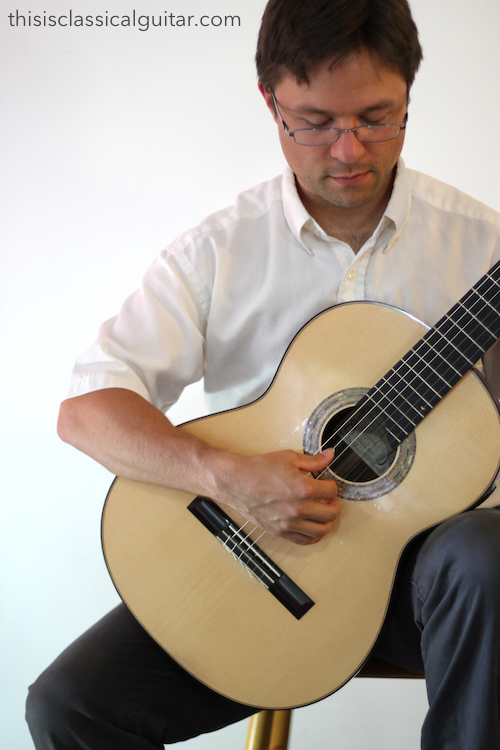
Again, the align your spine and head with the Y axis and your shoulders with the X axis. If you didn’t see it before check out the other article on basic sitting posture for classical guitar: Basic Posture and Sitting Position.
Line R shows how your right wrist is straight, that is, in-line with your forearm.
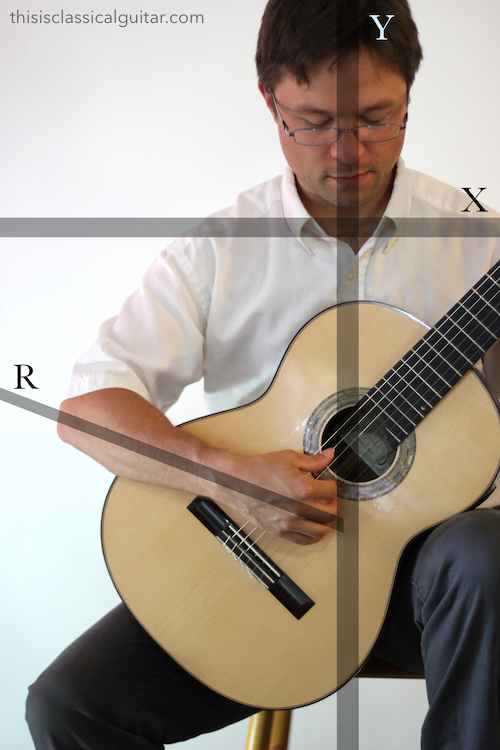
The Right Hand Arch
You can see in this photo that the right wrist has a natural and relaxed arch. This is very important. Don’t force the arch or over-do-it just let it naturally arch.
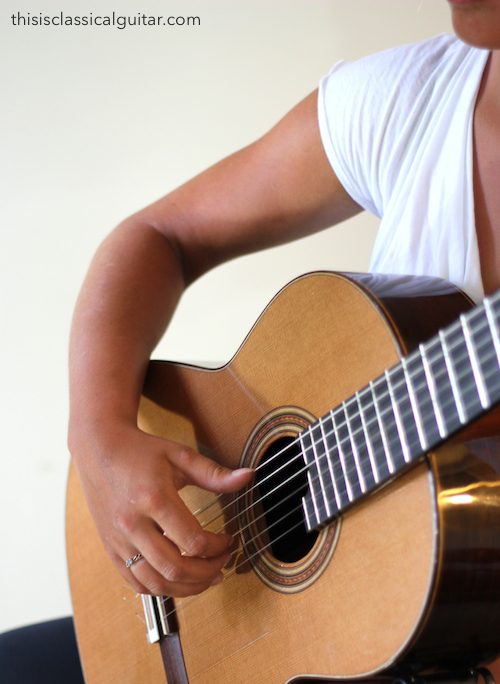
Line A refers to the contact point below of the arm on the guitar. It contacts below the elbow but well before the wrist. Line B indicates the natural and relaxed arch.
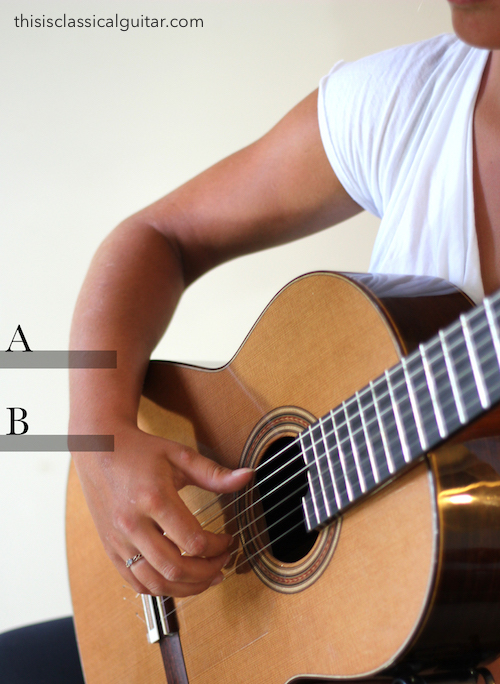
Right Hand Arch
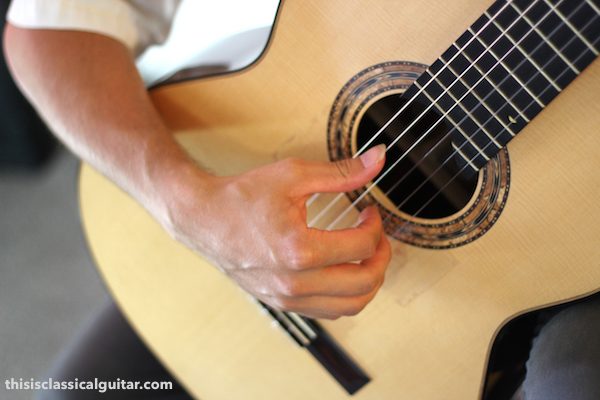
Line A is the contact point of the arm on the guitar. Line B is the natural and relaxed arch to the wrist. Line P shows the thumb extended naturally away from the fingers (more on this when we get to the right hand article). Line I is the direction that the I finger will move (in toward the palm). Again, I’ll cover this in a separate article.
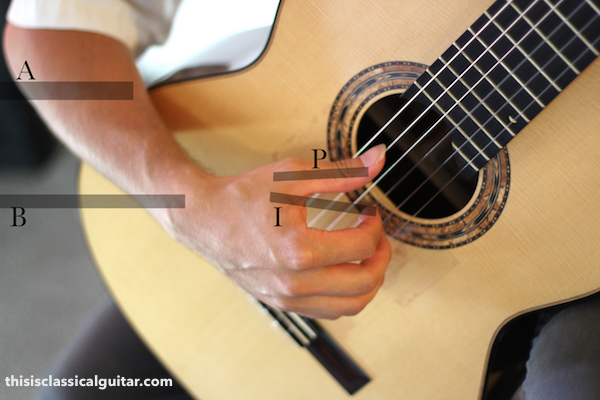
A Closer Look at the Right Hand
The next three photos show my hand in three different places: ponticello (near the bridge, bright sound), normal by the rosette (balanced sound), and tasto (near the fingerboard, warm sound). You can also make changes to the sound by changing the angle at which the fingers approach the strings but that will be in a later video.
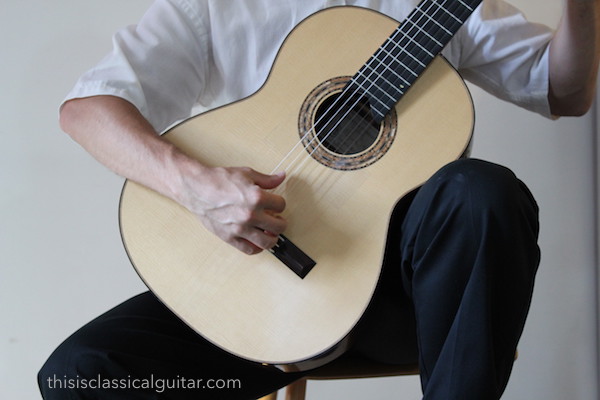
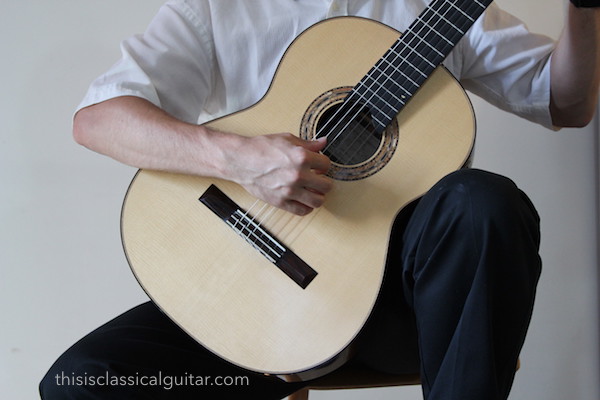
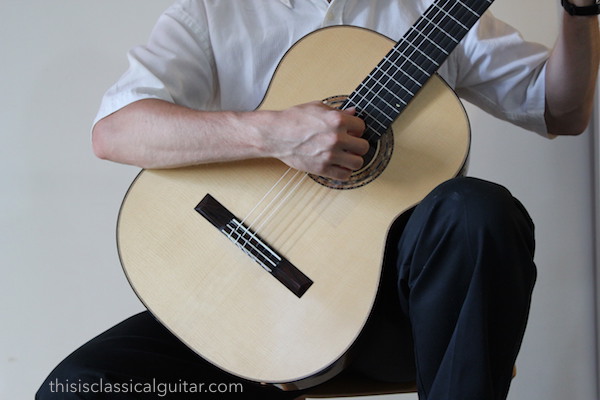
You can notice below that my student’s thumb nail is very different than mine. You might want to check out my article: Fingernails for Classical Guitar: How I Shape My Nails, everyone is a bit different.
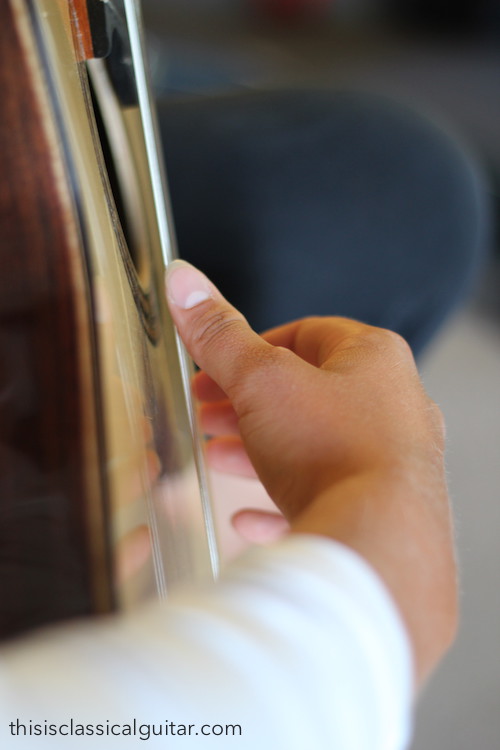
The next two photos show how the fingers move in toward the palm and inside the thumb. This is from the player’s perspective so you should be able to imitate the motion (also see the above video for a more clear explanation).
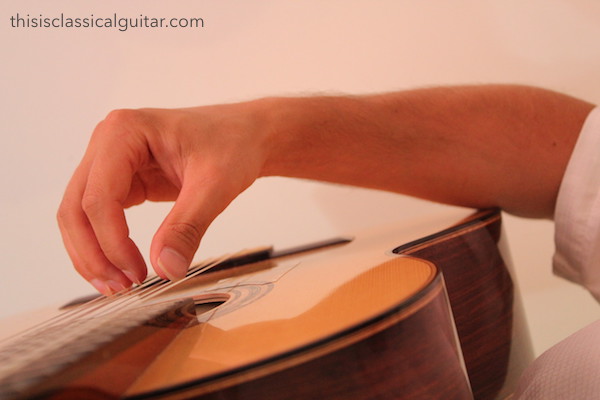
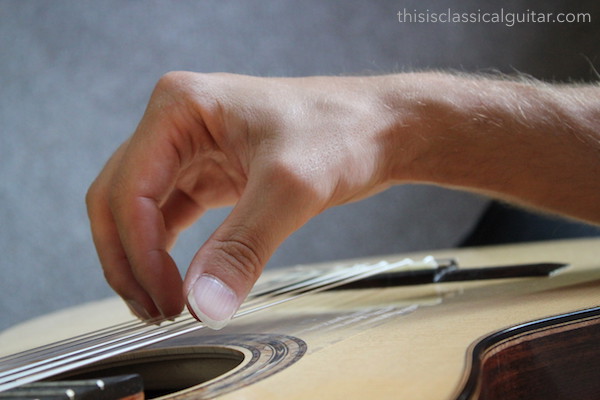
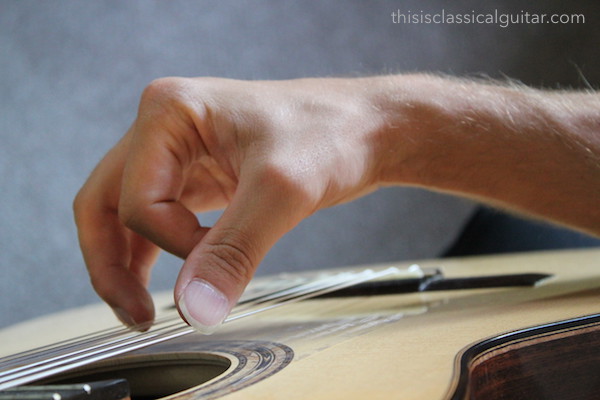
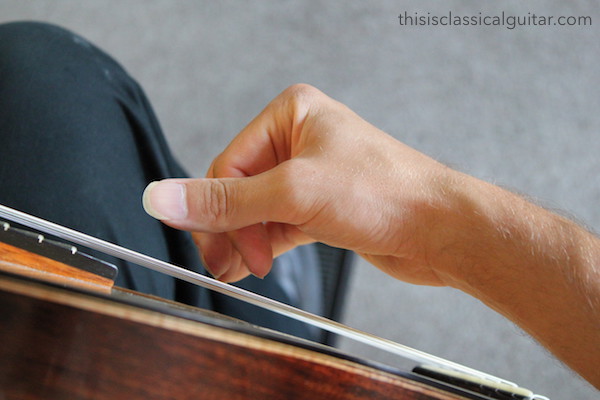
I’ve included two more photos here just for your reference. You should notice the curvature in the fingers. Every joint and knuckle create a new angle.
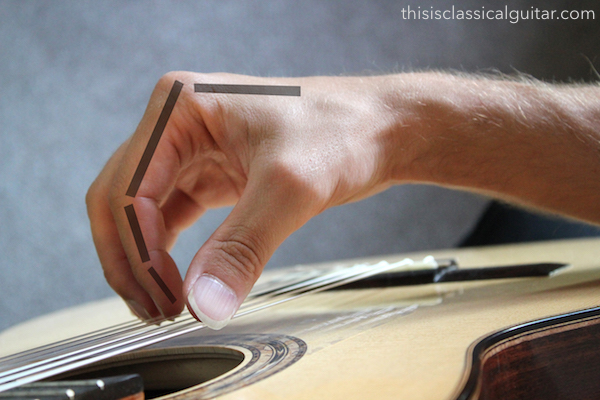
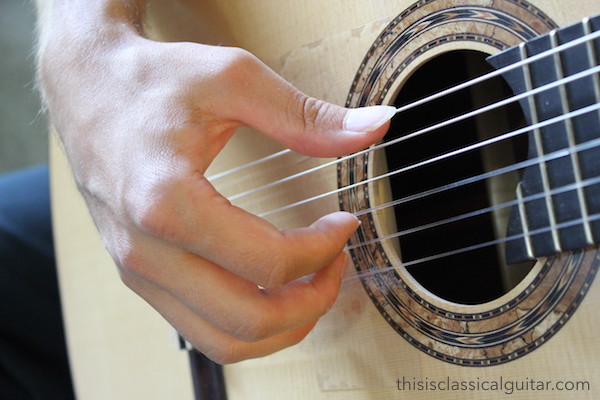
More free lessons: Lesson Archive for Classical Guitar
Books by Bradford: Visit the Sheet Music Page
More Free Lessons:
Check out my educational book series
- Classical Guitar Method Volume 1, with Video Lessons, 100 pages, Free PDF
- Classical Guitar Method Volume 2, with Video Lessons, 89 pages.
- Classical Guitar Technique: Essential Exercises, Scales, & Arpeggios

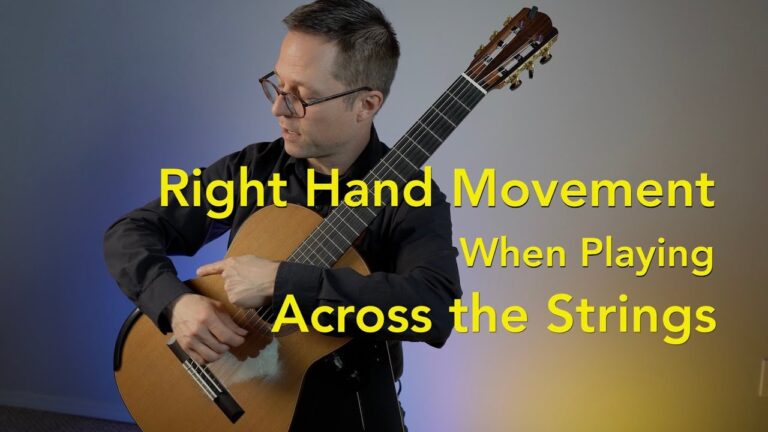


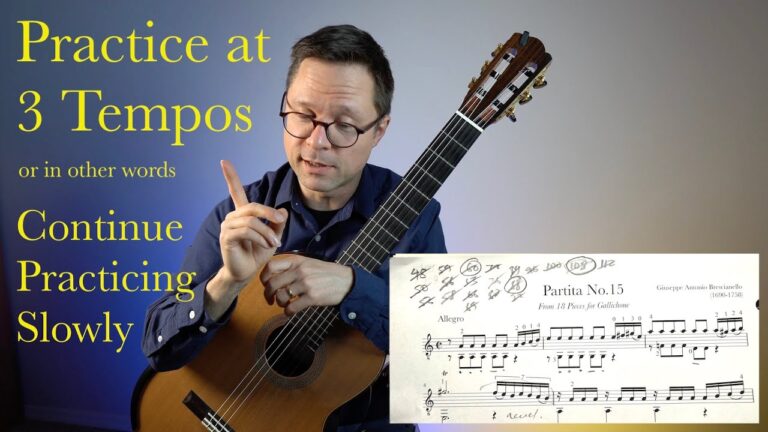
I played a classical guitar a decade ago, before my marriage. Back then, I thought I was pretty good. But actually, I had so many bad habits that kept me from becoming a really good player. I am trying now to learn the proper way this time and your diagrams have been so insightful and inspiring to me in trying to correct my technique. I am guilty of just about every single error. Crab-clamping the neck to make barre chords, wrists bent at awkward angles, etc. After just some time reading your lessons and looking at the diagrams, I was able to barre without all of the struggle and wrist pain I used to go through, especially the first and second frets. Thank you so much for these valuable resources. I really can’t wait to learn again.
I am working on your grade three book. Have gone through all your books. Can’t play all the pieces perfectly but am trying. Really enjoying it you are amazing. Have taken three years of local classics lessons. But I have trouble with rolling my chords. It’s sounds so beautiful when that is done instead of block chords. I have adjust my guitar have adjust my right hand position to correct the straight wrist position. But still can’t successfully roll my chords. Sometimes yes but most time not. It’s just a quick m i a arpeggio right? Or do you sometimes do a m i? Whichever way sounds good to me. But I guess it takes lots of practice it get it right.
It’s more of a gesture rather than something you can force your fingers to do. Almost a relaxed pulling away but on a micro level yes it is just an arpeggio. Just work on finger independence and relaxation and it will come in time.
What is the proper angle for the finger nail at the point of striking the string? Should it be roughly parallel to the string, or should it be at more of an oblique angle? Thank you very much. I appreciate your site.
Have you seen my dedicated fingernail lesson? https://www.thisisclassicalguitar.com/fingernails-on-classical-guitar/
That was very helpful. Thank you. I am currently working with your classical guitar technique book. Much appreciated.
Is alternation a “must”?..how important is it, and why?
Watch this video for my answer (but, YES, is the answer): https://www.thisisclassicalguitar.com/alternating-right-hand-fingers-classical-guitar/
I see the right hand exercises in the back. I’ll pay closer attention to them. Thanks 🙂
How do we know what fingers to use when we play a piece that both has chords and melody? I see some fingerings in the textbook and I’m confused as to how you chose them. What is the logic? I feel lost in my right hand technique. I can play the notes left hand but each time I play right hand it feels different.
Good question. My first answer is to study technique exercises a good deal. The ones at the back of my free book are a good start. Technique exercises not only train your fingers in good habits but also inform them as to which fingerings are efficient. The rest depends on the context of the piece you are playing. You said something about a “text book” but which one are you using? Are you talking about my method book vol. 1? If so, I discuss most fingerings in the videos for each piece.
I’m using #2. For me It’s mostly a question of when to use the a finger instead of m for example.
Hi,
is it safe to assume that your books: “Classical Guitar Method Vol. 1” and “20 Favorite Exercises”, along with the videos, is a great place to start out on classical guitar? I know a dozen chords or so, but I can’t play a whole tune, so I am basically total newbie. 🙂
Thanks in advance!
Yes, that would be a great start. The method will get you reading music and the technique/exercise book will boost your physical skills.
your lessons are seriously changing my life. I’ve been playing guitar, mostly untrained for 15 years!
Is it ok to rest your pinky on the face of the guitar?
Steel-string players often rest their pinky and historically some early music players might as well. However, in general, classical guitarist do not rest their pinky as they are aiming for maximum relaxation and dexterity int he hand. Support for the hand comes from the forearm contact point on the guitar and the weight of the arm by way of gravity.
This is marvellous. Thank you so much.
Have her constantly demonstrate to you and her teacher the correct AND incorrect hand position so she clearly understands what to do and not do. Constantly have her correct her hand after every singe phrase in the music. If it has to be said 100 times do it. You can make a funny joke or saying to keep it fun. If they are young, I call the flat wrist and hand “the crab” and every time I see I simply say the word CRAB!
Hello Bradford,
thank you for your very informative and useful site. My question is about how to correct this right hand bad habit in a young learner.
My 13 year old daughter has been learning guitar for a year now, taking a weekly lesson with a classical guitar teacher, and practicing. She has made decent progress.
However, her right hand position seems terrible to me (I am a very amateurish amateur). There is hardly any distance between her wrist and the strings, so the thumb is completely parallel to the string it plays, and the base of the thumb is almost touching the string. This results in a thumb movement that has to go outwards from the string, making a very long trip before it returns. I don’t even understand how she can manage to play that way. I keep telling her to arch the hand by separating the wrist from the strings so the thumb meets the string at an angle, not parallel to it etc. She does it for two seconds and immediately goes back to her old ways. I am afraid this may become a habit impossible to correct.
If you have any suggestions as to how to go about correcting this, I’d appreciate it.
thank you.
Hi, your daughter is clearly very wise as she is correct, the thumb and indeed the fingers should contact the string at their central tips, with fingers straight, this is correct, playing with the thumb taking a crazy side swipe as most players do is ridiculous as there is no way that the thumb nail can contact the string like this unless it could be persuaded to balloon out to the left and this is of course impossible. The side swipe technique will cause circulation trouble (pins and needles) and painful injury while the parallel position it sounds like your daughter has allows for a superb apoyando that should be the primary means of expression.